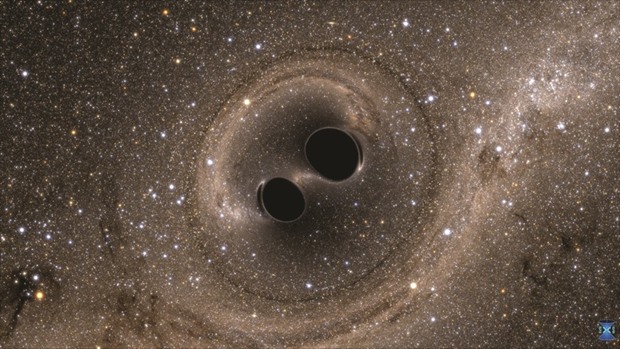In a landmark discovery for physics and astronomy, scientists said yesterday they have glimpsed the first direct evidence of gravitational waves, ripples in the fabric of space-time that Albert Einstein predicted a century ago.
When two black holes collided some 1.3bn years ago, the joining of those two great masses sent forth a wobble that hurtled through space and reached Earth on September 14, 2015, when it was picked up by sophisticated instruments, researchers announced.
“Up until now we have been deaf to gravitational waves, but today, we are able to hear them,” said David Reitze, executive director of the LIGO Laboratory, at a packed press conference in the US capital.
Reitze and colleagues compared the magnitude of the discovery to Galileo’s use of the telescope four centuries ago to open the era of modern astronomy.
“I think we are doing something equally important here today. I think we are opening a window on the universe,” Reitze said.
The phenomenon was observed by two US-based underground detectors, designed to pick up tiny vibrations from passing gravitational waves, a project known as the Laser Interferometer Gravitational-wave Observatory, or LIGO.
It took scientists months to verify their data and put it through a process of peer-review before announcing it yesterday, marking the culmination of decades of efforts by teams around the world including some 1,000 scientists from 16 countries, according to the National Science Foundation, which funded the research.
Gravitational waves are a measure of strain in space, an effect of the motion of large masses that stretches the fabric of space-time - a way of viewing space and time as a single, interweaved continuum.
They travel at the speed of light and cannot be stopped or blocked by anything.
As part of his theory of general relativity, Einstein said space-time could be compared to a net, bowing under the weight of an object. Gravitational waves would be like ripples that emanate from a pebble thrown in a pond.
While scientists have previously been able to calculate gravitational waves, they had never before seen one directly.
According to the Massachusetts Institute of Technology’s (MIT) David Shoemaker, the leader of the Advanced LIGO team, it looked just like physicists thought it would.
“The waveform that we can calculate based on Einstein’s theory of 1916 matches exactly what we observed in 2015,” he said.
“It looked like a chirp, it looked at something that started at low frequencies - for us low frequencies means 20 or 30 hertz, that’s like the lowest note on a bass guitar, sweeping very rapidly up over just a fraction of a second... up to 150 hertz or so, sort of near middle C on a piano.”
The chirp “corresponded to the orbit of these two black holes getting smaller and smaller, and the speed of the two objects going faster and faster until the two became a single object,” he explained.
“And then right at the end of this waveform, we see the wobbling of the final black hole as if it were made of jelly as it settled into a static state.”
The L-shaped LIGO detectors - each about 2.5 miles (4km) long - were conceived and built by researchers at MIT and Caltech.
One is located in Hanford, Washington, and the other is in Livingston, Louisiana. A third advanced detector, called VIRGO, is scheduled to open in Italy later this year.

The collision of two black holes - a tremendously powerful event detected for the first time ever by the Laser Interferometer Gravitational-wave Observatory, or LIGO - is seen in this still image from a computer simulation released in Washington.
